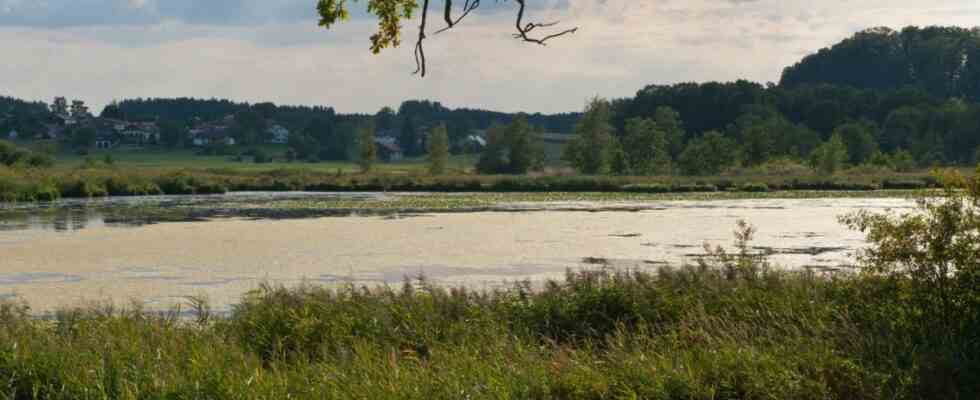The Ebersbergers love him. And not just them: Day trippers from the state capital who are in the mood for a natural idyll like to do their rounds around the Egglburger See, through ancient avenues, over springy meadows, past proud farms. Ornithologists also get their money’s worth, many rare birds have their breeding grounds here. But the idyll is endangered, which no one could escape this summer: A huge carpet of algae stretched across the water surface, the banks are more and more overgrown by aquatic plants. “The lake has lost some of its power,” says a woman from Ebersberg who lives nearby and is very worried about the development on her walks. “I’m not a biologist and I’m not a specialist – but you have to do something!”
A number of Ebersbergers have also contacted Roswitha Holzmann, deputy head of the Lower Nature Conservation Authority, who are worried about the lake this year. She was also in contact with the owner of the nature reserve on the outskirts of Ebersberg – because the jewel actually belongs to the city itself Not. But even if you’re a biologist and a specialist like Holzmann, you can’t conjure up a patent solution.
Algae growth started after a storm
Two phenomena were responsible for the lake being in a worse condition this year than it used to be. On the one hand, according to Holzmann, a storm completely overturned the shallow lake, the deposited sediments were whirled upwards, containing nutrients from decades that, in combination with the oxygen in the upper layers and the persistently shining sun, produced the massive growth of algae. On the other hand, the summer also had very little precipitation, and Holzmann estimates that the water level was 20 to 30 centimeters lower than usual in summer – which is why larger parts of the lake shore also silted up.
The silting up at Lake Egglburger See is not a process that has just been set in motion, in principle it began centuries ago. As Holzmann explains, it does not have large inlets that feed the lake, the water comes from a few springs that flow out of the forest and also from precipitation that collects in the basin. And if less follows, the lake just gets smaller. Those who know the lake well, such as Ebersberg’s mayor Ulrich Proske, have been able to observe the phenomenon over the past few decades: “When I was a child, the lake was bigger than it is now,” he recalls, “where the reed banks used to be, there is now forest growing. “
But what can you do? Can you do anything at all? Difficult, says Roswitha Holzmann. Dredging would be an option, but also “a bottomless pit,” as the deputy head of the nature conservation authority explains. Hundreds of trucks of mud would have to be hauled away, which would not only cost a lot of money, but also raise the question of whether such a measure is even advisable in a valuable nature conservation and flora-fauna-habitat area. The purpose of a nature reserve is to let nature be, not to interfere – even if people don’t necessarily like the result.
The mayor would like to have an expert opinion made on the chain of ponds
Holzmann has also looked at a way to keep algae growth in the lake under control. A company from Simssee has developed a technique in which the algae can be bound with specially treated quartz sand and proposed it for use in Lake Egglburger and Klostersee. Although some municipalities that have already tested this report successful therapy against excessive aquatic plant growth, there is still no scientific evidence that this method is effective, says Holzmann. She would therefore not advocate an application in such a valuable nature reserve as Egglburg Lake: “I can imagine trying something like this first on a small village pond.”
In the Klostersee, the mayor also wants to do without this technology for the time being, even if he views the situation at the chain of ponds with concern. To ensure that clean water arrives in the Klostersee, a settling tank has already been built, he explains, and there has not been a serious algae problem in the Klostersee – the popular bathing pond in the district town – this year either. But the Klostersee, like the entire chain of ponds, is dependent on the water that comes from Lake Egglburg. If the Egglburger See is doing badly, the chain of ponds also suffers. According to Proske, he therefore wanted to have an expert opinion drawn up on how the situation is likely to develop here – whether in ten years or in 100 years there will still be enough water flowing from Lake Egglburg towards Klostersee. “In times of climate change, anything is possible,” says the mayor, adding that he wants to know what the city could face.
The expert in the nature conservation authority also finds forecasts difficult. The silting up of the lake will certainly continue, says Holzmann, so at some point Egglburger See could go the same way as the lake in Kirchseeon, which gave the place its name but, as is well known, has long since disappeared. Holzmann is convinced that this will certainly take a long time to come at Lake Egglburg: At least the next two generations will be able to continue to experience it as a beautiful large lake

